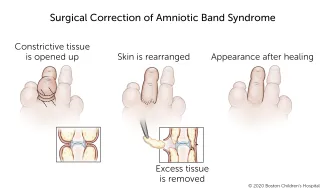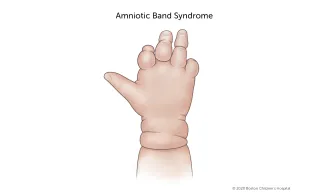Amniotic Band Syndrome | Symptoms & Causes
What are the symptoms of amniotic band syndrome?
Amniotic band syndrome can vary in its presentation, and the severity of symptoms can differ from one individual to another. From the maternal perspective, it will usually be asymptomatic. Some fetal symptoms and presentation of amniotic band syndrome include:
- Limb abnormalities
- Constriction rings or grooves around fingers, toes, arms, or legs
- Missing fingers, toes, or parts of limbs
- Clubbed foot or other limb deformities
- Facial deformities
- Organ damage: Rarely, bands may cause damage to internal organs, potentially leading to issues such as gastrointestinal or genitourinary abnormalities.
- Swelling or edema in the areas affected by the constricting bands.
- Restricted blood flow caused by bands wrapping the umbilical cord.
What causes amniotic band syndrome?
The exact cause of amniotic band syndrome isn’t known. Doctors don’t think the condition is hereditary (passed from parent to child). Many cases seem to happen for no clear reason.
Amniotic Band Syndrome | Diagnosis & Treatments
How is amniotic band syndrome diagnosed?
Amniotic band syndrome may be diagnosed before birth through an ultrasound or fetal MRI; it may also be discovered only after delivery.
How is amniotic band syndrome treated?
Treatment for amniotic band syndrome varies for each patient. Shallow bands that don’t interfere significantly with limb or digit function and don’t involve the umbilical cord may not need prenatal surgery (during the pregnancy). In cases of prenatal diagnosis of deeper amniotic bands that affect limb appearance and movement, or if there are concerns regarding bands around the umbilical cord, fetal surgery may be necessary to release or remove the constricting bands. Postnatal repair to sustain and improve limb function or for aesthetic reasons may require one or more surgeries that are usually scheduled around the age of 1 or older.
Overall, treatment for amniotic band syndrome is tailored to the specific needs of the child and may involve a combination of monitoring, surgical interventions, plastic and orthopedic measures, and rehabilitation therapies. At Boston Children’s, our multidisciplinary team collaborates to provide comprehensive care and support from diagnosis through your child’s development.

How we care for amniotic band syndrome at Boston Children’s Hospital
At the Fetal Care and Surgery Center, we collaborate with your primary obstetrics team to diagnose and evaluate the severity of the amniotic band syndrome if diagnosed prenatally. Advanced imaging, such as comprehensive ultrasound and fetal MRI, can help determine if fetal surgery is an option, and will be followed by a comprehensive assessment with state-of-the-art fetal imaging will be taken. We conduct multidisciplinary consultations with our pediatric radiologists, maternal-fetal medicine specialists, and fetal surgeons to determine the need for prenatal intervention and follow-up.
Postnatally, our Orthopedic and Sports Medicine Department's Hand and Orthopedic Upper Extremity Program and Department of Plastic and Oral Surgery’s Hand and Reconstructive Microsurgery Program have treated thousands of babies and children with amniotic band syndrome and other hand conditions. With extensive experience spanning from common to highly complex cases, they offer unparalleled diagnosis, treatment, and care. They are also at the forefront of pioneering clinical and scientific research.
Recognized as a premier center for pediatric musculoskeletal care, our Orthopedic and Sports Medicine Department specializes in addressing developmental, congenital, neuromuscular, sports-related, traumatic, and post-traumatic issues in children and young adults.
Similarly, our Department of Plastic and Oral Surgery stands as one of the world’s most extensive and proficient centers for pediatric plastic and oral surgery, delivering comprehensive care for a wide spectrum of congenital and acquired conditions, including various hand deformities.



